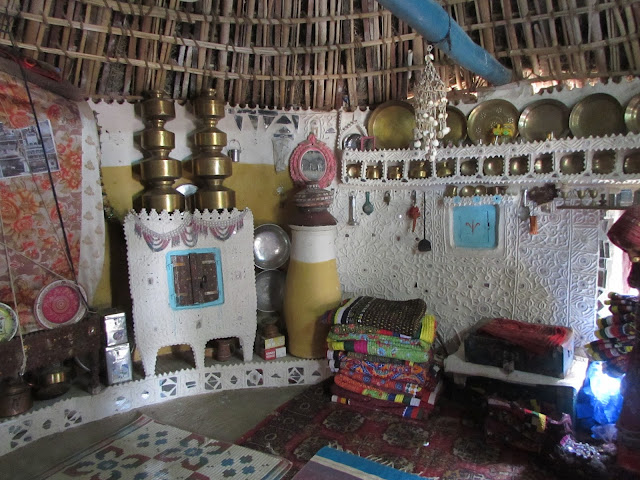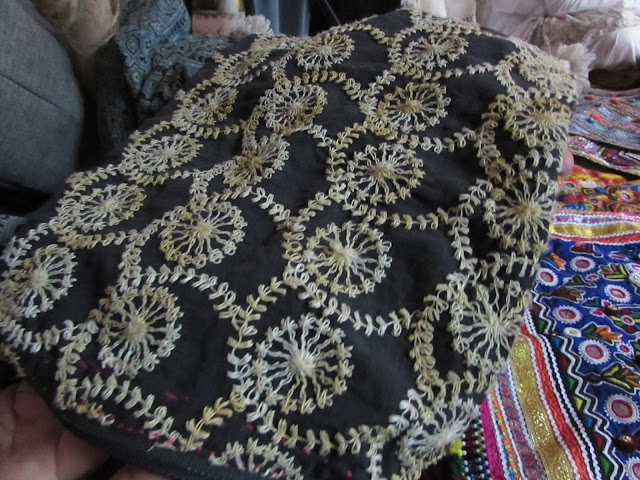Ludyia Village is a traditional desert village, where the women are known for their embroidery. Over the last while, the place has ben mentioned in assorted guide books, and so is more touristy than it was, but the people have adapted, making a variety of craft items to sell.
The homes and clothing are traditional, and Charllotte arranged with an older local woman to tell us about dowry.
A note about the people who educate us - Charlotte does not like it when tourists visit a place and then repay the inhabitants by buying their cheaply made items. She calls this "pity buying". Maiwa functions on the principle that craft is a worthwhile endeavour, and is deserving of payment for both materials and time. All the people who spend time with us are paid for this time. The places we visit that offer shawls, printed fabric, jewelry, and other items, give us a chance to buy quality goods made with artistry, but the time we spend with the local people is considered to be at least as valuable, for both them and us, as are the items we buy and the money we leave behind.
This is a typical house. It's one room, round, with a conic roof, and is about fifteen feet in diameter. The cooking area is elsewhere, and is communal. The white thing with a blue frame around a darker square in the first picture is not an oven, as some of us thought, but is a cabinet.
You can see a pile of quilts in the middle picture, and there are more stacked behind the orange fabric hanging in the first photo. Quilts are brought out at night, and are used as both beds and coverlets. I asked how many people sleep in a house like this, and was told eight.
The woman talked to us through an interpreter. She told us that in her time, a dowry consisted of two to four hand embroidered blouses, and about the same number of quilts, plus assorted jewelry. Nowadays, though, dowries are much larger, and an entire village provides items for the bride-to-be.
In rural areas, a woman moves to the village of her husband, while men stay at home with their parents and bring their new wife into their home. A woman's dowry today will include forty or more fabric items, shirts, skirts, other clothing, and quilts, as well as jewelry.
Here you can see some of the handwork that goes into making an item.
The two pictures below show a bag.
Here are some members of our group, sitting in awe as the pile of dowry items grows.
Here is some jewelry. The women in the desert wear large pieces, anklets, bracelets, necklaces, and nose rings.
These are anklets.
Bangles.
A necklace.
Earrings.
The front and back of what might be a nose ring.
The large ring of this item is a nose ring. It has a beaded strap attacked that can be clipped to hair, to help support its weight. I have a good picture of our hostess wearing it. She rolled her eyes when she saw me trying to demonstrate how it's worn, and insisted on putting it on to show me, but I can't publish the picture here.
This is a closeup of part of the home's inner wall, to show the decoration. The work is all done by hand, and is freehand.
Below is a view through one of the windows of some quilts hanging outside.
And here are more quilts. Most are whole-cloth, and quilted by hand with lines of running stitch.
This quilt is one of the few appliqued ones I've seen
Here are some of the items the people had for sale.
Here are some exterior views of the homes.
Everywhere we've been, we are offered a place to sit and some tea. Sometimes the seat is a cheap plastic chair, sometimes it's a folded quilt on the ground, but we are always made comfortable. The tea is usually masala chai. "Masala" means a mix of spices, and"chai" is tea. There are different masalas, vegetable, for example, which can be used to make soup or a sauce to have on meat. The tea masalas vary a bit from place to place, but I've enjoyed them all. Spiced tea is usually served with milk, and sometimes it's already sweet and sometimes I've added a bit of sugar. First thing in the morning, or later in the day if I have a dusty throat, a sweet milky tea is wonderful.
Below is how our chai was made in this village.
The homes and clothing are traditional, and Charllotte arranged with an older local woman to tell us about dowry.
A note about the people who educate us - Charlotte does not like it when tourists visit a place and then repay the inhabitants by buying their cheaply made items. She calls this "pity buying". Maiwa functions on the principle that craft is a worthwhile endeavour, and is deserving of payment for both materials and time. All the people who spend time with us are paid for this time. The places we visit that offer shawls, printed fabric, jewelry, and other items, give us a chance to buy quality goods made with artistry, but the time we spend with the local people is considered to be at least as valuable, for both them and us, as are the items we buy and the money we leave behind.
This is a typical house. It's one room, round, with a conic roof, and is about fifteen feet in diameter. The cooking area is elsewhere, and is communal. The white thing with a blue frame around a darker square in the first picture is not an oven, as some of us thought, but is a cabinet.
You can see a pile of quilts in the middle picture, and there are more stacked behind the orange fabric hanging in the first photo. Quilts are brought out at night, and are used as both beds and coverlets. I asked how many people sleep in a house like this, and was told eight.
The woman talked to us through an interpreter. She told us that in her time, a dowry consisted of two to four hand embroidered blouses, and about the same number of quilts, plus assorted jewelry. Nowadays, though, dowries are much larger, and an entire village provides items for the bride-to-be.
In rural areas, a woman moves to the village of her husband, while men stay at home with their parents and bring their new wife into their home. A woman's dowry today will include forty or more fabric items, shirts, skirts, other clothing, and quilts, as well as jewelry.
Here you can see some of the handwork that goes into making an item.
The two pictures below show a bag.
Here are some members of our group, sitting in awe as the pile of dowry items grows.
Here is some jewelry. The women in the desert wear large pieces, anklets, bracelets, necklaces, and nose rings.
These are anklets.
Bangles.
A necklace.
Earrings.
The front and back of what might be a nose ring.
The large ring of this item is a nose ring. It has a beaded strap attacked that can be clipped to hair, to help support its weight. I have a good picture of our hostess wearing it. She rolled her eyes when she saw me trying to demonstrate how it's worn, and insisted on putting it on to show me, but I can't publish the picture here.
This is a closeup of part of the home's inner wall, to show the decoration. The work is all done by hand, and is freehand.
Below is a view through one of the windows of some quilts hanging outside.
And here are more quilts. Most are whole-cloth, and quilted by hand with lines of running stitch.
This quilt is one of the few appliqued ones I've seen
Here are some of the items the people had for sale.
Here are some exterior views of the homes.
Everywhere we've been, we are offered a place to sit and some tea. Sometimes the seat is a cheap plastic chair, sometimes it's a folded quilt on the ground, but we are always made comfortable. The tea is usually masala chai. "Masala" means a mix of spices, and"chai" is tea. There are different masalas, vegetable, for example, which can be used to make soup or a sauce to have on meat. The tea masalas vary a bit from place to place, but I've enjoyed them all. Spiced tea is usually served with milk, and sometimes it's already sweet and sometimes I've added a bit of sugar. First thing in the morning, or later in the day if I have a dusty throat, a sweet milky tea is wonderful.
Below is how our chai was made in this village.






























No comments:
Post a Comment